Python Remove Punctuation From String
Importing the necessary module
Before we start removing punctuation marks from strings, we need to import the necessary module. In Python, the ‘string’ module provides a set of constants that represent the ASCII characters that are considered punctuation marks. To import the module, we can use the following code:
“`
import string
“`
Check if the string contains punctuation marks
Now that we have imported the ‘string’ module, the next step is to check if a given string contains any punctuation marks. For this purpose, we can iterate over each character in the string and check if it is present in the ‘string.punctuation’ constant. If any character matches, it means the string contains a punctuation mark. Here is an example code snippet that demonstrates this:
“`
import string
def has_punctuation_marks(text):
for char in text:
if char in string.punctuation:
return True
return False
“`
In the above code, we define a function called ‘has_punctuation_marks’ that takes a ‘text’ parameter. We then iterate over each character in the ‘text’ and check if it is present in the ‘string.punctuation’ constant. If we find a match, we return True indicating that the string contains a punctuation mark. If no match is found, we return False.
Create a function to remove punctuation marks
Now that we can check if a string contains punctuation marks, let’s move on to the next step of actually removing them. We can create a function that takes a string as input and returns the string without any punctuation marks. Here is an example implementation:
“`
import string
def remove_punctuation_marks(text):
return ”.join(char for char in text if char not in string.punctuation)
“`
In the above code, we define a function called ‘remove_punctuation_marks’ that takes a ‘text’ parameter. We then create a new string by iterating over each character in the ‘text’ and checking if it is not present in the ‘string.punctuation’ constant. If the character is not a punctuation mark, we include it in the new string using the ‘join’ method. Finally, we return the new string without any punctuation marks.
Apply the function to the string
Now that we have a function to remove punctuation marks from a string, let’s apply it to a given string. Here is an example code snippet that demonstrates this:
“`
import string
def remove_punctuation_marks(text):
return ”.join(char for char in text if char not in string.punctuation)
example_string = “Hello, World!”
modified_string = remove_punctuation_marks(example_string)
print(modified_string)
“`
In the above code, we define a function called ‘remove_punctuation_marks’ that is the same as the one mentioned earlier. We then create an ‘example_string’ variable that holds the string “Hello, World!”. We apply the ‘remove_punctuation_marks’ function to this string and store the modified string in the ‘modified_string’ variable. Finally, we print the modified string, which should be “Hello World” without any punctuation marks.
Example code: removing punctuation from a given string
Here is an example code snippet that demonstrates how to remove punctuation from a given string using the ‘translate’ method in Python:
“`
import string
def remove_punctuation_marks(text):
translator = str.maketrans(”, ”, string.punctuation)
return text.translate(translator)
example_string = “Hello, World!”
modified_string = remove_punctuation_marks(example_string)
print(modified_string)
“`
In the above code, we define a function called ‘remove_punctuation_marks’ that takes a ‘text’ parameter. We then create a translator using the ‘str.maketrans’ method, which maps each character in the ‘string.punctuation’ constant to None. Finally, we apply the translator to the ‘text’ using the ‘translate’ method and return the modified string.
FAQs
Q: What is the ‘string.punctuation’ constant?
A: The ‘string.punctuation’ constant is a string that contains all the ASCII punctuation characters.
Q: How can I check if a string contains punctuation marks in Python?
A: You can iterate over each character in the string and check if it is present in the ‘string.punctuation’ constant.
Q: Can I remove punctuation marks from a string using regular expressions in Python?
A: Yes, you can use the ‘re’ module in Python to remove punctuation marks from a string using regular expressions.
Q: Are there any other methods to remove punctuation marks from a string in Python?
A: Yes, besides the methods mentioned in this article, you can also use the ‘replace’ method or regular expressions to remove punctuation marks from a string in Python.
In conclusion, removing punctuation marks from a string in Python is a common task that can be accomplished using various methods. The ‘string’ module provides a set of constants that represent the ASCII punctuation characters, which can be used to check if a string contains punctuation marks. We can then create a function that removes these punctuation marks from a given string. Applying the function to the string results in a modified string without any punctuation marks. By following the guidelines and example codes provided in this article, you should be able to effectively remove punctuation marks from strings in Python.
Python Regex: How To Remove Punctuation
How To Remove Punctuation From String In Python Using Function?
Introduction:
When working with text data in Python, it is quite common to encounter the need to remove punctuation from strings. Punctuation marks are special characters like periods, commas, exclamation marks, etc., that are used to enhance the structure and meaning of sentences. However, in certain cases, they can be unwanted and hinder text processing tasks such as natural language processing, sentiment analysis, or even simple string matching. In this article, we will explore various methods to remove punctuation from a string in Python, utilizing functions to create reusable code.
Methods to Remove Punctuation:
1. Using String Punctuation Constants:
Python offers a built-in string constant called `punctuation` in the `string` module. This constant contains all punctuation marks commonly used in English. We can use this constant in combination with the `str.translate()` method to remove punctuation from a string.
“`python
import string
def remove_punctuation(text):
translator = str.maketrans(”, ”, string.punctuation)
return text.translate(translator)
“`
Explanation: The `str.maketrans()` method returns a translation table that maps each character in the first argument to the corresponding character in the second argument, and deletes all characters that are in the third argument. By passing empty strings for the first two arguments and `string.punctuation` for the third argument, we obtain a translation table that removes all punctuation marks from the text. The `str.translate()` method then applies this translation table to the input string, effectively removing the punctuation.
2. Using Regular Expressions:
Another powerful method to remove punctuation from a string is by using regular expressions. Python provides the `re` module that allows us to leverage the regular expression syntax to perform pattern matching operations on strings.
“`python
import re
def remove_punctuation(text):
return re.sub(r'[^\w\s]’, ”, text)
“`
Explanation: The `re.sub(pattern, replacement, string)` function replaces all occurrences of the pattern in the input string with the replacement string. In this case, the pattern `[^\w\s]` matches any character that is not a word character (`\w` matches alphanumeric characters and underscores) or a whitespace character (`\s` matches spaces, tabs, etc.). By replacing such characters with an empty string, we effectively remove all punctuation marks from the text.
FAQs:
Q1. How can I remove punctuation while preserving non-English characters?
A. Both methods discussed above rely on the `string.punctuation` constant, which is specifically tailored for English punctuation. If you need to remove punctuation from strings containing non-English characters, you can create your own translation table by including the required punctuation marks.
Q2. What if I only want to remove specific punctuation marks?
A. In such cases, you can modify the translation table or the regular expression pattern accordingly. For example, if you only want to remove commas and periods, you can modify the translation table as `str.maketrans(”, ”, ‘,.’)` or the regular expression pattern as `[.,]` respectively.
Q3. What happens to punctuation marks within words?
A. Both methods discussed treat words with punctuation marks within them as independent words and do not remove the punctuation. For example, “can’t” will be considered two words, “can” and “t”. If you wish to remove punctuation within words as well, you can modify the regular expression pattern as `r'[^\w\s]|[_]’` (this removes underscores too).
Q4. Can I apply these methods to remove punctuation from an entire text file?
A. Absolutely! You can use these methods to remove punctuation from strings obtained by reading the contents of a text file. After removing punctuation, you can save the processed text to another file.
Conclusion:
Removing punctuation from strings is a common requirement in text processing tasks. In this article, we explored two methods to accomplish this using functions in Python. By using the built-in string punctuation constants or regular expressions, we can easily remove punctuation marks from strings, facilitating various text analysis tasks. Always remember to choose the method that best suits your specific needs and the nuances of your text data. Happy coding!
How To Remove Punctuation From A String Python Using For Loop?
Punctuation marks are often unwanted when dealing with textual data in Python. Whether you need to count word occurrences, analyze sentiments, or perform any other text processing tasks, removing punctuation can streamline the process. In this article, we will explore how to remove punctuation from a string using a for loop in Python.
The for loop is a powerful construct in Python that allows us to iterate over elements in a given sequence. By leveraging the for loop along with some string manipulation methods, we can efficiently remove punctuation marks from a string.
Step 1: Import Required Modules
To begin, we need to import the string module, which provides a list of punctuation marks. The code snippet below demonstrates how to import the string module:
import string
Step 2: Define the String
Next, let’s define the string from which we want to remove punctuation marks. This can be any text string or a user input. Here’s an example:
text = “Hello, world! This is a sample text, with punctuation marks.”
Step 3: Initialize an Empty String
Now, let’s initialize an empty string where we will store the modified text without punctuation marks. We will call this string “result”.
result = “”
Step 4: Iterate Through the String
In this step, we will iterate through each character of the input string using a for loop. For each character, we will check if it is a punctuation mark. If it is not, we will add it to the “result” string.
for char in text:
if char not in string.punctuation:
result += char
Step 5: Output the Modified String
Finally, let’s print the modified string without punctuation marks:
print(result)
When you run the code snippet, the output will be: “Hello world This is a sample text with punctuation marks.”
FAQs
Q1. What does string.punctuation contain?
String.punctuation is a constant string of all ASCII punctuation marks, including characters like commas, periods, question marks, exclamation points, and more. It essentially provides a ready-made collection of punctuation marks against which we can compare the characters in the input string.
Q2. Are whitespace characters considered as punctuation?
No, whitespace characters such as space, tab, or newline are not considered as punctuation marks. The string.punctuation constant only includes the ASCII punctuation symbols.
Q3. Can I remove punctuation from multiple strings using this method?
Yes, you can remove punctuation from multiple strings using this method. Simply define each string separately and repeat the process outlined above for each string.
Q4. What if I want to keep certain punctuation marks in the string?
If you want to keep certain punctuation marks and only remove others, you can modify the code inside the for loop to suit your requirements. Instead of checking if the character is not in string.punctuation, you can explicitly define the punctuation marks you want to exclude. For example:
for char in text:
if char not in “!.”:
result += char
Q5. Can I use regular expressions to remove punctuation marks instead of a for loop?
Yes, regular expressions offer a powerful way to manipulate strings in Python. You can use the re module to replace punctuation marks with an empty string using regular expressions. However, using a for loop approach is often easier to understand and implement for simple cases like this.
In conclusion, removing punctuation from a string using a for loop in Python is a practical skill for working with textual data. By leveraging the string module and the for loop construct, you can efficiently remove unwanted punctuation marks, allowing for easier text processing and analysis tasks.
Keywords searched by users: python remove punctuation from string Remove punctuation Python, Remove punctuation python nltk, Python remove substring, Remove punc python, 3. remove empty strings from a list of strings, Split punctuation Python, Remove symbol from string Python, Remove punctuation from string JavaScript
Categories: Top 50 Python Remove Punctuation From String
See more here: nhanvietluanvan.com
Remove Punctuation Python
Punctuation is an integral part of any written language, providing structure and context to the text. However, there are scenarios when you might want to remove punctuation from a given string of text, such as when performing sentiment analysis or text mining. In this article, we will explore various techniques and methods to remove punctuation using Python.
Why Remove Punctuation?
Before delving into the nitty-gritty of removing punctuation, let’s briefly discuss why you might need to do so. Removing punctuation has several applications, including:
1. Sentiment Analysis: When analyzing sentiment in text, punctuation marks like exclamation points and question marks don’t contribute to the overall sentiment and can be safely eliminated.
2. Text Mining: In text mining tasks, such as topic modeling or clustering, punctuation can add noise to the analysis. By removing punctuation, you can improve the accuracy and quality of your results.
3. Data Cleaning: Punctuation clutter can interfere with data cleaning efforts, particularly when dealing with large datasets. Removing punctuation marks simplifies the process of preprocessing text data.
Now, let’s move on to different methods you can employ to remove punctuation using Python.
Method 1: Regular Expressions
Regular expressions, also known as regex, are a powerful tool for pattern matching and manipulating strings in Python.
We can use the `re` module in Python to remove punctuation. Here’s an example:
“`python
import re
def remove_punctuation(text):
pattern = r'[^\w\s]’
return re.sub(pattern, ”, text)
text = “Hello! How are you? I’m fine, thank you.”
clean_text = remove_punctuation(text)
print(clean_text)
“`
Output:
“`
Hello How are you Im fine thank you
“`
In this example, the `remove_punctuation` function takes a string (`text`) and uses the `'[^\w\s]’` pattern to match any character that is not a word character (`\w`) or whitespace (`\s`). The `re.sub` method replaces all matches with an empty string, effectively removing the punctuation.
Method 2: String Translation
Another practical approach to removing punctuation in Python is by leveraging the `str.translate()` method along with the `string.punctuation` constant.
Consider the following code snippet:
“`python
import string
def remove_punctuation(text):
translator = str.maketrans(”, ”, string.punctuation)
return text.translate(translator)
text = “Hello! How are you? I’m fine, thank you.”
clean_text = remove_punctuation(text)
print(clean_text)
“`
Output:
“`
Hello How are you Im fine thank you
“`
In this method, we create a translator using `str.maketrans()`, which maps each punctuation character to `None`. The `str.translate()` method then applies this translation map to remove the punctuations from the input string.
Frequently Asked Questions (FAQs):
Q1: Will the above methods remove punctuation from non-English text?
Yes, both methods would remove punctuation from non-English text as well. They are not language-specific and can be applied to any text containing punctuation marks.
Q2: How can I remove punctuation while keeping certain characters, such as apostrophes?
To remove punctuation while keeping apostrophes, you can modify the regular expression pattern as follows:
“`python
pattern = r'[^(\w|\’)\s]’
“`
This pattern ensures that apostrophes are not removed while still removing other punctuation marks.
Q3: Are there any alternative libraries or packages for removing punctuation?
Yes, there are alternative libraries such as NLTK (Natural Language Toolkit) or spaCy that provide built-in functionalities for text processing, including punctuation removal. These libraries often offer additional features such as tokenization, part-of-speech tagging, and lemmatization.
Conclusion
Removing punctuation is a common pre-processing step in various text analysis tasks. Python provides several methods to achieve this, from regular expressions to string translation. Depending on your specific requirements and preferences, you can choose the method that best suits your needs. Remember to keep in mind any language-specific considerations and explore existing libraries for text processing tasks. By eliminating punctuation clutter, you can enhance the accuracy and efficiency of your text analysis pipelines.
Remove Punctuation Python Nltk
When it comes to text analysis and natural language processing, dealing with punctuation marks is often an important step in cleaning and preparing the data. Punctuation marks not only add noise to the text but can also interfere with the accuracy of certain analyses or models. In this article, we will explore how to remove punctuation using the Python programming language and the Natural Language Toolkit (NLTK).
The NLTK is a powerful library in Python that provides a wide range of tools and resources for working with human language data. It allows us to perform countless operations on text, including tokenization, tagging, stemming, and more. It also offers various corpora and functionalities for pre-processing text. Here, we will specifically focus on removing punctuation from text using the NLTK library.
To begin, we need to ensure that the NLTK library is installed. If it is not, open your command prompt or terminal and execute the command:
“`
pip install nltk
“`
Once NLTK is successfully installed, we can proceed with the necessary imports in our Python script. The following code should be added at the beginning of your script:
“`python
import nltk
nltk.download(‘punkt’)
“`
The `nltk.download(‘punkt’)` line downloads the Punkt tokenizer package, which the NLTK library uses for tokenization. Tokenization is the process of splitting the text into individual tokens or words, and we will utilize this functionality to remove punctuation.
Now, let’s dive into the core of the topic: removing punctuation from text. We will provide two alternative approaches to achieve this.
Approach 1: Using string.punctuation
Python’s `string` module encompasses a predefined constant named `punctuation`. This constant holds all the punctuation marks recognized by the interpreter. By leveraging this, we can easily remove punctuation from text using list comprehensions and the `str.join()` method. Here’s an example:
“`python
import string
def remove_punctuation(text):
return ”.join([char for char in text if char not in string.punctuation])
“`
In this example, `remove_punctuation()` takes a string `text` as input and applies a list comprehension to iterate over each character in the text. If the current character is not present in the `string.punctuation`, it is appended to a new list. Finally, the `str.join()` method is used to concatenate the characters and return a string without punctuation.
Approach 2: Using NLTK’s RegexpTokenizer
NLTK offers a regular expression tokenizer, `RegexpTokenizer`, which allows us to define regex-based patterns for tokenizing. We can utilize this tokenizer to only include alphanumeric characters while ignoring punctuation marks. Here’s an example:
“`python
from nltk.tokenize import RegexpTokenizer
def remove_punctuation(text):
tokenizer = RegexpTokenizer(r’\w+’)
tokens = tokenizer.tokenize(text)
return ‘ ‘.join(tokens)
“`
In this approach, the `RegexpTokenizer` with the pattern `r’\w+’` is used to tokenize the input text. The pattern `\w+` matches one or more alphanumeric characters, effectively excluding punctuation. The resulting tokens are then joined using the `str.join()` function to reconstruct the text without punctuation.
Both approaches will yield the same result: text without any punctuation marks. You can choose the approach that better fits your specific case, although the second approach using NLTK’s tokenizer provides more flexibility if you need to perform further tokenization or processing on the text.
FAQs
1. What punctuation marks are considered in string.punctuation?
The `string.punctuation` in Python includes the following characters: !”#$%&'()*+,-./:;<=>?@[\]^_`{|}~.
2. Are whitespace characters considered punctuation?
No, whitespace characters like spaces or tabs are not considered punctuation. If you also want to remove whitespace, you can modify the code in the approaches provided accordingly.
3. Is it possible to remove punctuation marks without NLTK?
Yes, it is possible to remove punctuation marks from text without using NLTK. As shown in the first approach, you can utilize the string module’s `punctuation` constant and apply custom logic to remove the punctuation characters.
4. Can NLTK handle languages other than English?
Yes, NLTK is capable of handling multiple languages. However, keep in mind that the behavior and results might vary for different languages as punctuation rules differ.
In conclusion, removing punctuation marks from text using Python and the NLTK library is a relatively straightforward process. By following the provided approaches, you can easily preprocess text data and prepare it for various natural language processing tasks. Remember that the choice of approach depends on your requirements and the specific use case.
Python Remove Substring
Python is a powerful and versatile programming language that provides numerous functionalities for developers. When it comes to manipulating strings, Python offers a wide range of built-in methods and tools to handle various string operations. In this article, we will explore how to remove substrings from a string using Python, examining different approaches and techniques. Whether you are a beginner or an experienced Python developer, this guide will help you understand the intricacies of removing substrings in Python.
Understanding Substrings
Before diving into the different methods of removing substrings, let’s first define what a substring is. In simple terms, a substring is a smaller string that is contained within a larger string. For example, in the word “Hello,” the substrings would be “H,” “e,” “l,” “l,” and “o.” Removing substrings involves eliminating or replacing these smaller strings within a larger string.
Using the Replace() Method
One of the easiest ways to remove substrings in Python is by using the replace() method. This method replaces all occurrences of a substring with another value. The syntax for the replace() method is as follows:
new_string = old_string.replace(substring, replacement)
Let’s visualize this with an example:
“`python
string = “Hello, World!”
new_string = string.replace(“o”, “”)
print(new_string)
“`
Output: “Hell, Wrld!”
In this example, we remove all occurrences of the letter “o” from the string “Hello, World!” by replacing it with an empty string.
Using Slicing
Another effective approach to removing substrings in Python is by utilizing slicing. Slicing allows you to extract a portion of a string based on its indices. By combining and manipulating slices, you can effectively remove substrings.
Here’s an example of how to remove a substring using slicing:
“`python
string = “Hello, World!”
substring = “o”
new_string = string[:string.index(substring)] + string[string.index(substring) + len(substring):]
print(new_string)
“`
Output: “Hell, Wrld!”
In this example, we find the index of the first occurrence of the substring “o” using the index() method. We then slice the original string into two parts: one before the substring and one after the substring. Finally, we concatenate these two slices to form the new string without the substring.
Using Regular Expressions
Python’s re module provides powerful tools for pattern matching and manipulating strings using regular expressions. Removing substrings based on patterns can be fully accomplished using regular expressions. The sub() function from the re module allows us to substitute matches with alternative text or an empty string, thus removing the desired substring.
Consider the following example:
“`python
import re
string = “Hello, World!”
substring = “o”
new_string = re.sub(substring, “”, string)
print(new_string)
“`
Output: “Hell, Wrld!”
In this example, we utilize the sub() function from the re module to remove all occurrences of the substring “o” from the original string.
FAQs
Q: Can I remove multiple substrings at once?
A: Yes, you can remove multiple substrings at once by utilizing any of the methods mentioned above within a loop or by chaining the methods.
Q: What if the substring occurs multiple times within the string?
A: All of the methods discussed will remove all occurrences of the substring by default. If you only need to remove the first occurrence, slight modifications to the code are required. For example, using slicing, you can specify the exact indices to remove only the first occurrence.
Q: Can I remove substrings in a case-insensitive manner?
A: Yes, by converting both the original string and the substring(s) to lowercase (or uppercase) before applying any of the removal methods. This ensures that the case of the characters in the substrings does not affect the removal process.
Q: Are there any limitations to using regular expressions for removing substrings?
A: Regular expressions provide a powerful tool for string manipulation, but they can be more complex and resource-intensive compared to basic string methods. They should be used judiciously, especially in situations where performance is a concern.
Q: How can I remove leading or trailing substrings?
A: To remove leading or trailing substrings, you can use the lstrip() or rstrip() methods, respectively, in combination with any of the other methods described above.
Conclusion
Python offers various methods to remove substrings from a given string. Whether you prefer to use string methods such as replace(), slicing, or the full power of regular expressions, Python has you covered. By understanding the nuances of these techniques, you will be able to manipulate strings effectively in your Python programs. Remember to consider factors such as performance, case-sensitivity, and the number of occurrences when choosing the most suitable methodology. Happy coding!
Images related to the topic python remove punctuation from string
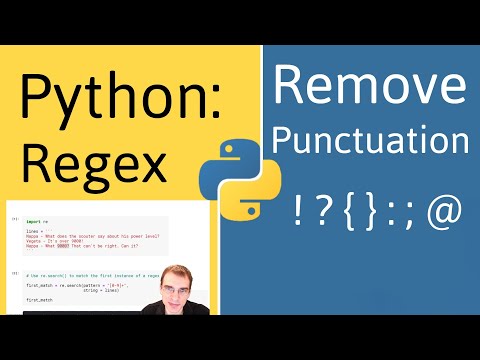
Found 16 images related to python remove punctuation from string theme


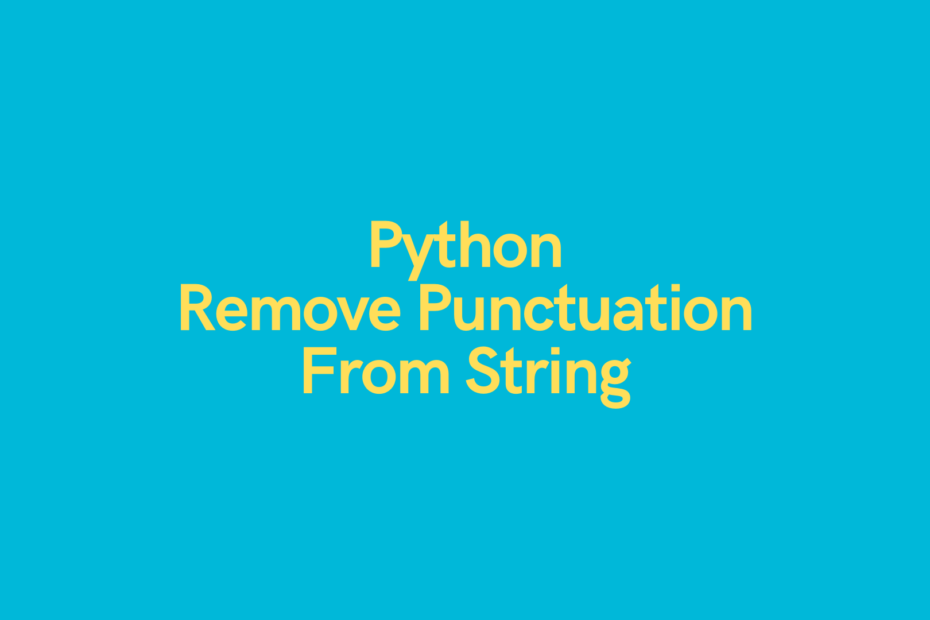
.png)





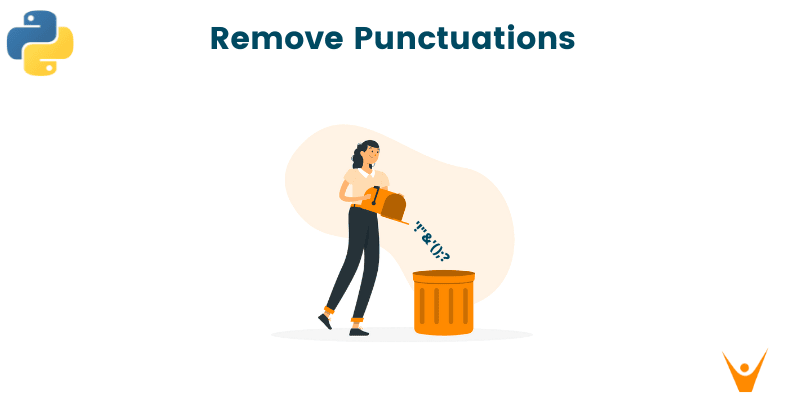

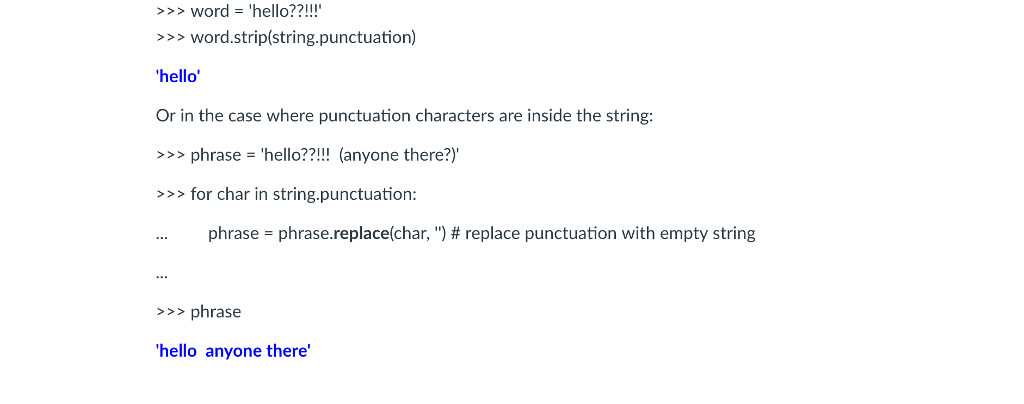
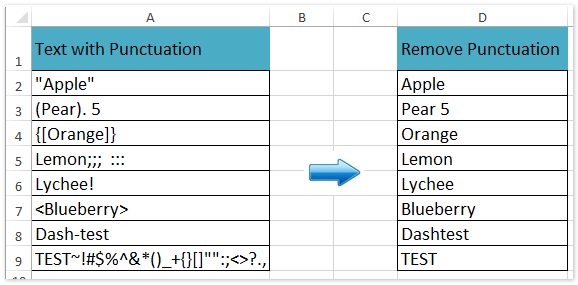




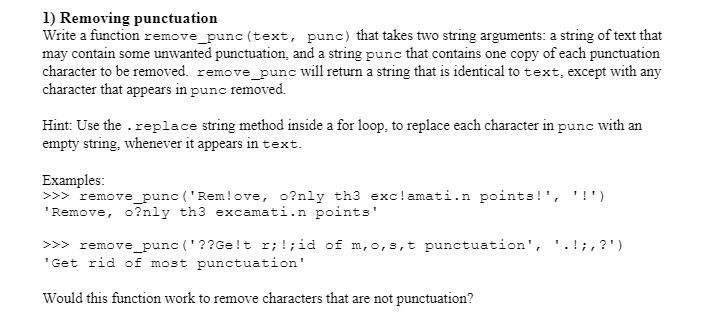
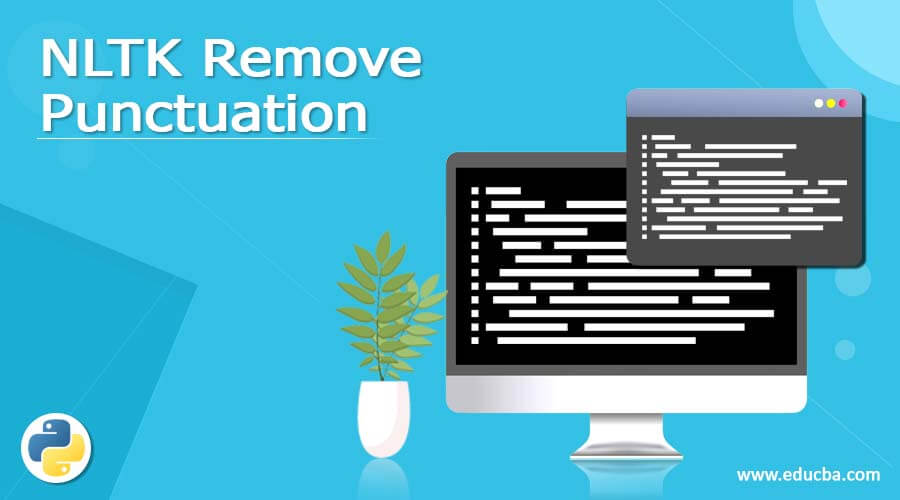

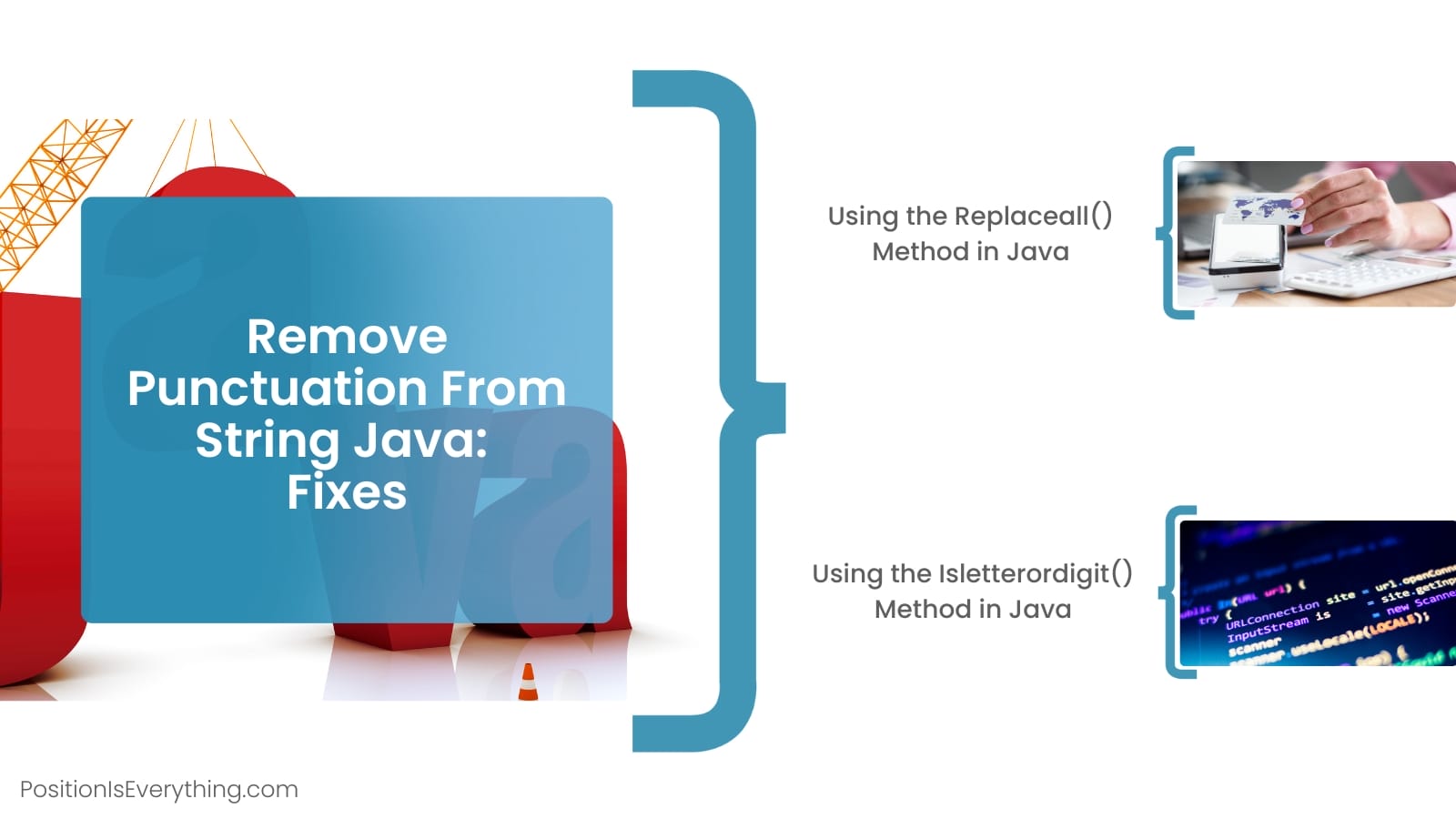





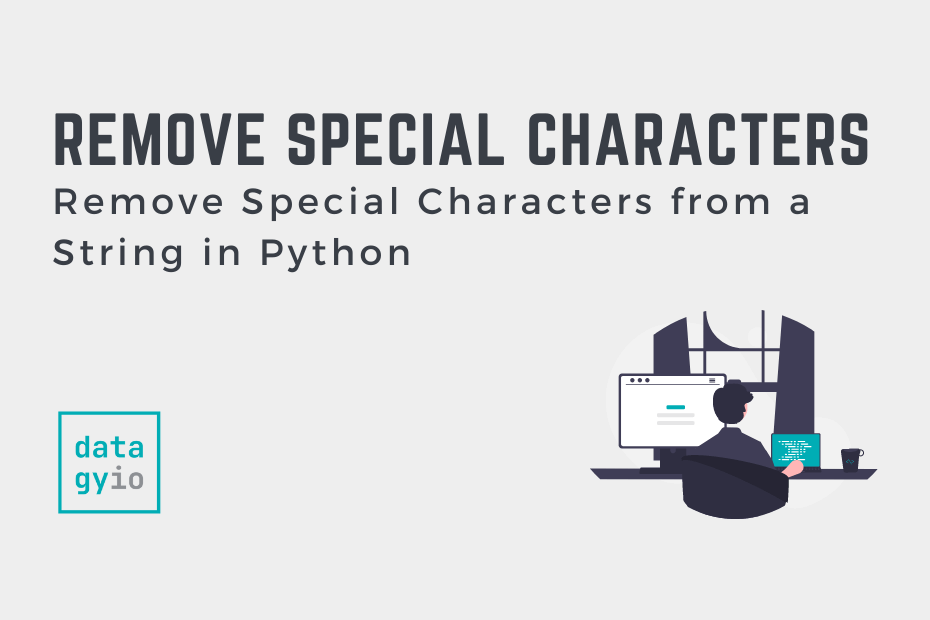







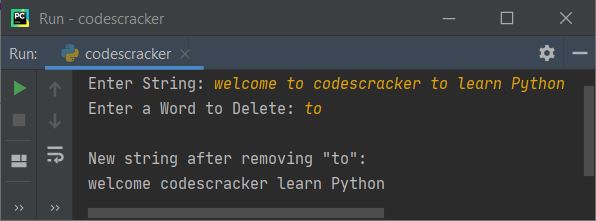

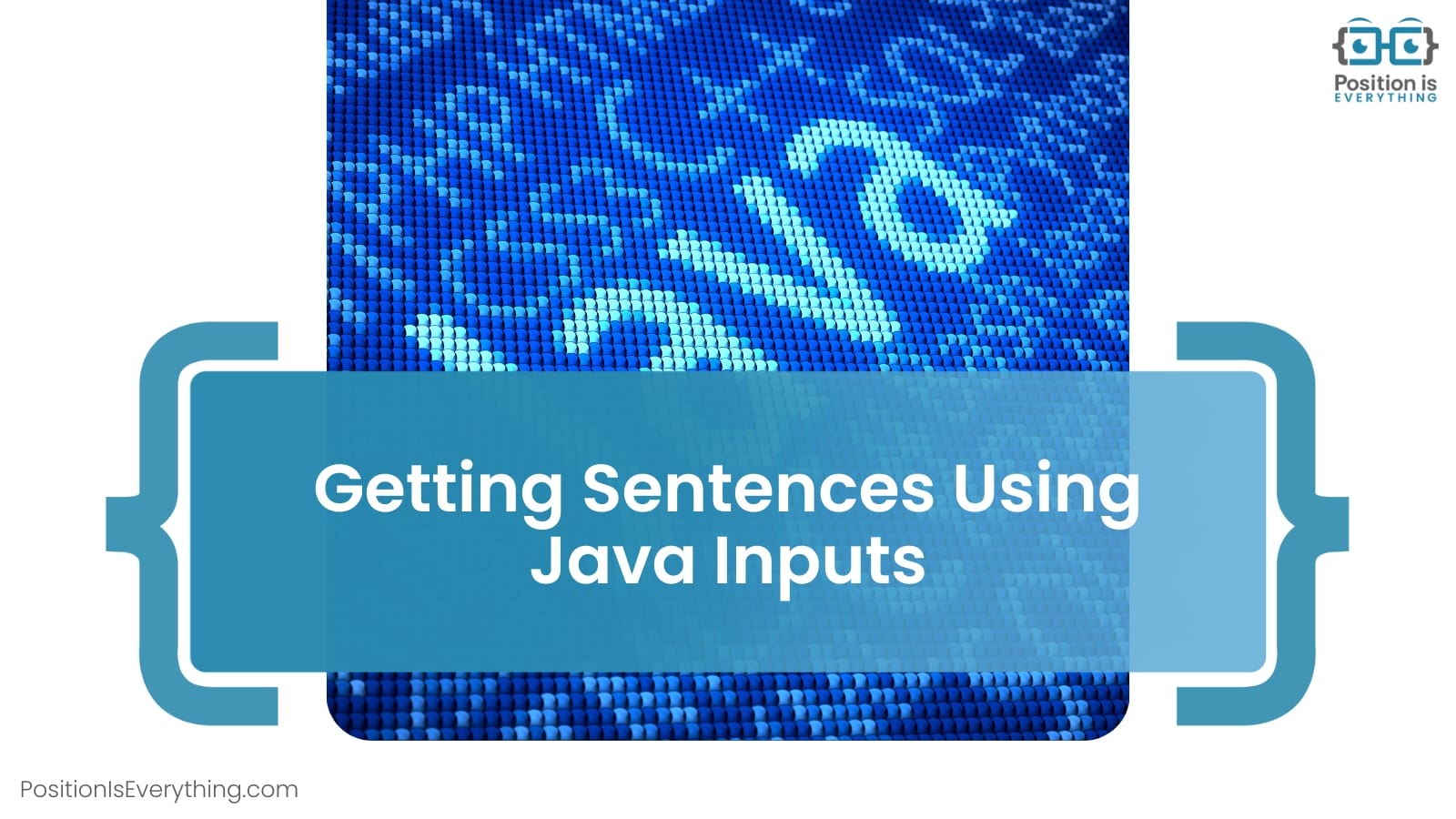



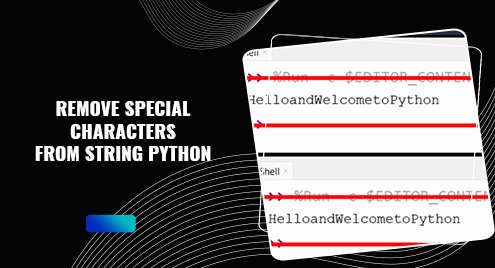


![Python Program to Remove Vowels from String Solved: Please Use Python Or; Tacked On At The End. Clearo Will Return A List With The Original Words Stripped Of The Punctuation. >>> >>> A=[‘Asd,’Er.,’Rt,’,’Fgh;’] >>>Cleara) [‘Asd’, ‘Er’, ‘Rt’,’Fgh’] >>>” style=”width:100%” title=”SOLVED: please use python or; tacked on at the end. clearO will return a list with the original words stripped of the punctuation. >>> >>> a=[‘asd,’er.,’rt,’,’fgh;’] >>>cleara) [‘asd’, ‘er’, ‘rt’,’fgh’] >>>”><figcaption>Solved: Please Use Python Or; Tacked On At The End. Clearo Will Return A List With The Original Words Stripped Of The Punctuation. >>> >>> A=[‘Asd,’Er.,’Rt,’,’Fgh;’] >>>Cleara) [‘Asd’, ‘Er’, ‘Rt’,’Fgh’] >>></figcaption></figure>
<figure><img decoding=](https://cdn.numerade.com/ask_images/17382307d34746fd9136e8c97d0ab108.jpg)


Article link: python remove punctuation from string.
Learn more about the topic python remove punctuation from string.
- Python: Remove Punctuation from a String (3 Different Ways!)
- Python | Remove punctuation from string – GeeksforGeeks
- Best way to strip punctuation from a string – Stack Overflow
- Python Program to Remove Punctuation From a String – Javatpoint
- Python Program to Remove Punctuations From a String
- Remove Punctuation from String using Python (4 Best Methods)
- Python Program to Remove Punctuations From a String
- Python: Remove Punctuation From String, 4 Ways
- Remove Punctuation from String Python – Scaler Topics
- Remove punctuation from a List of strings in Python – bobbyhadz
- Remove Punctuation Python – STechies
See more: https://nhanvietluanvan.com/luat-hoc